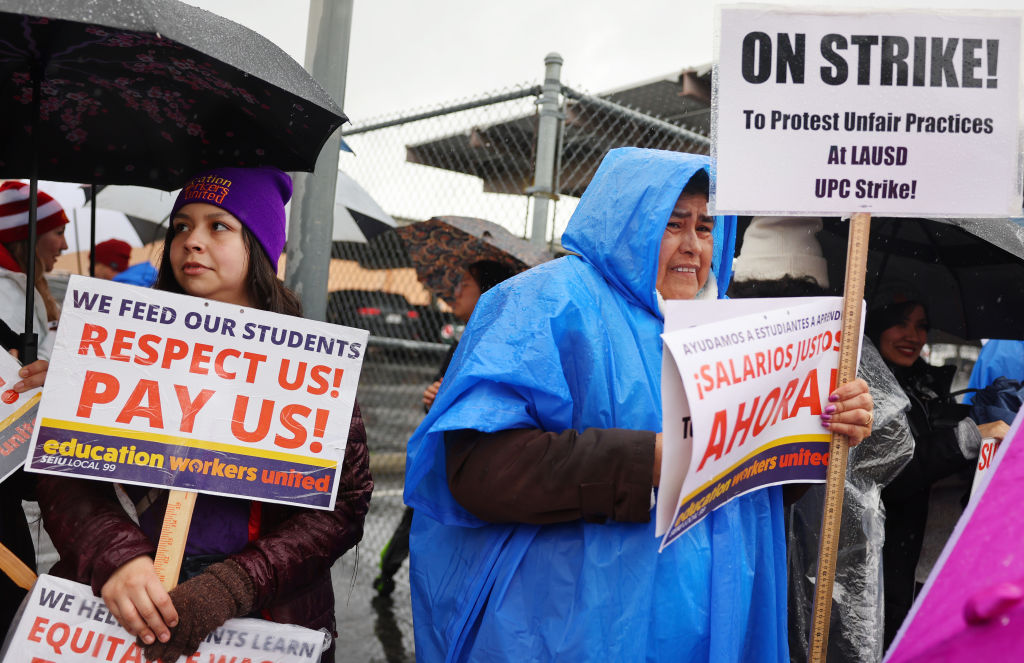
As often happens during labor disputes, the numbers are flying fast and furious among the Los Angeles Unified School District (LAUSD) and the two unions that have conducted a three-day strike to protest stalled negotiations, low wages and what they say are unfair labor practices.
Numbers like $25,000, which Local 99 of the Service Employees International Union (SEIU) says is the average annual wage of its district workers: bus drivers, cafeteria employees, custodians, special education assistants. It is a figure far below any real-world estimate of what it takes to live in Los Angeles. (Disclosure: SEIU is a financial supporter of Capital & Main.)
Numbers like 20%, the wage increase that United Teachers Los Angeles (UTLA) is seeking over the next two years, and 10%, the district’s latest offer, nine months after the expiration of its previous contract with the union. (LAUSD says it’s also offering one-time bonuses that would add up to nearly another 10%.)
They rattle around, these numbers. They get kicked back and forth like political footballs. But at the core, they all take a back seat to the biggest number of all.
That number is $4.9 billion. It represents the amount the district has parked in its General Fund Ending Balance — essentially, the money in LAUSD’s reserve.
And the question that affects the conversation around every one of those other numbers in play is a basic one: Can the district spend out of that reserve to pay its workers and teachers or not?
Remarkably, despite projecting the largest reserve in its long history, the LAUSD maintains that almost all of that money is accounted for and off limits. “We’re not sitting on $5 billion worth of reserves,” Superintendent Alberto Carvalho told the Los Angeles Times last month. “And to say that is inspiring false hope — period. I stand by that.”
The district’s own breakdown of the numbers, though, reveals the creative accounting behind them. The truth is that Carvalho and the LAUSD can choose to use the moment to kick-start a resurgence of the district, by raising teachers to a more competitive wage and workers to a livable one. They simply haven’t done so.
The $4.9 billion figure isn’t a figment of the unions’ imaginations; it represents the district’s pencil work on the subject. Asked for details about the reserve, a spokesperson furnished Capital & Main with LAUSD’s most recent update, and as of March 13, the district estimated $4.932 billion in its general fund balance.
Some of that is legitimately siloed. For example, $239 million of the total is required by the state to be set aside for economic uncertainty. Another $43 million is “non-spendable,” the district says, as it goes for inventories and prepaid items.
But the biggest chunks of the reserve fall into two categories — and one of them is almost purely discretionary. While $1.75 billion of the money is labeled “restricted,” meaning it was designated for specific uses by the entity that granted it (usually the federal government), the biggest piece — $2.33 billion — is simply designated as “committed.”
Committed to what? Well, to whatever the district wants it to be committed. LAUSD’s own description of the category labels the money as “resources constrained by limitations self-imposed by the District’s Board.”
That’s a lot of words to say the district can decide what to do with more than $2.3 billion of its reserve. In addition, union representatives contend that much of the federal money that flowed into the district during the COVID years of 2020 and 2021 — money that helped elevate the reserve to its astonishing current level — may be spent on teaching salaries to build back staff numbers, though the district hasn’t treated it as such.
Put together, the unions say, LAUSD has at least $3 billion in purely discretionary money at hand. Carvalho, remember, objected specifically to the notion that the district “is sitting on $5 billion worth of reserves.” Clearly, he’s not trying to answer the same question as the district’s teachers or wage workers.
The whole notion of a school district, even a massive one like L.A. Unified, needing a reserve fund in the billions is another conversation altogether. While school districts have always held money for emergency needs and economic downturns, the practice of building up reserves to extremes — including state reserve funding for California districts — accelerated rapidly after the Great Recession in 2008.
For the past decade, LAUSD has projected budget deficits every school year. In only one of those, 2019-20, did it actually show a deficit, based on documents viewed by union negotiators. Long before COVID money helped take its reserve levels to their current heights, the district was fattening its rainy-day funds and holding back cash for expenditures that either never materialized or didn’t rise to the level of projected need.
Without question, the district faces challenges. From its peak of more than 700,000 students in the early 2000s, LAUSD enrollment has dropped to about 420,000, and with that comes decreased state funding that is enrollment based. In addition, Carvalho had to use non-classroom credentialed employees last year to fill hundreds of teaching vacancies, and union sources say there are still teacher shortages across the district, including at many of its campuses of highest need — an ongoing story for LAUSD.
One way to attack the issue is to improve teacher pay and working conditions, the better to recruit top talent, and to retain a supporting staff of custodians, bus drivers, etc. — those who make the district run smoothly on a day-to-day basis. It all takes money.
How much, and how that money is distributed among the teachers and workers of LAUSD, is legitimately the subject of organized negotiations. But any suggestion that the district can’t afford to address the workers’ needs ought to be put to rest immediately. The money is there. It’s the will that’s lacking.







